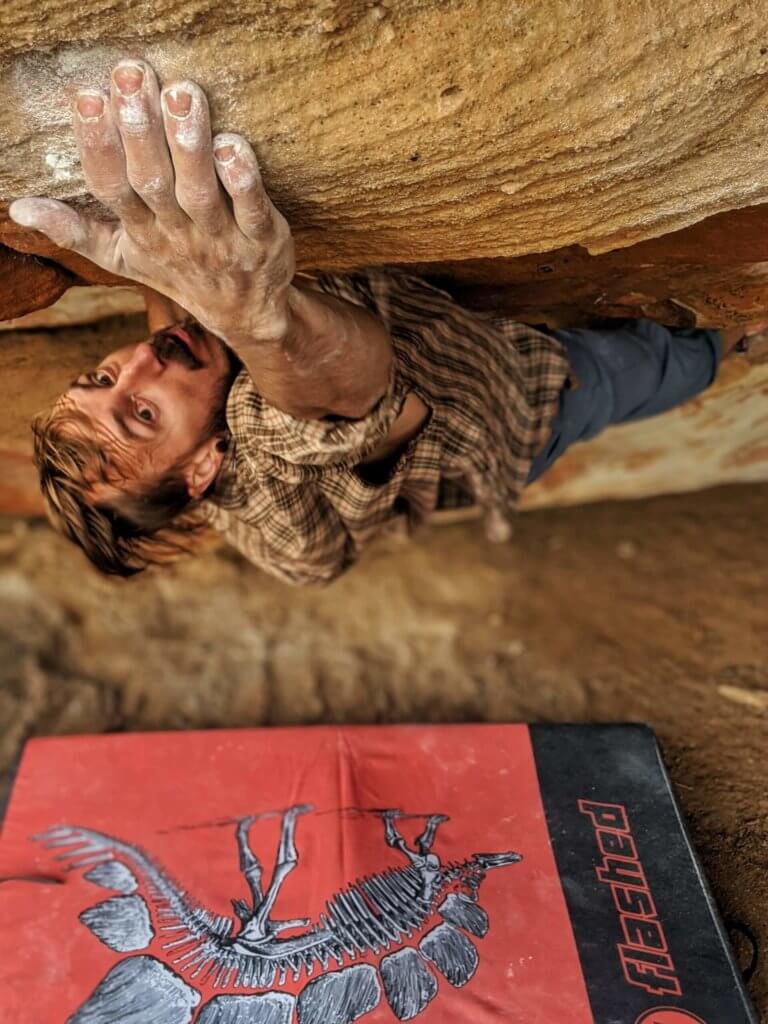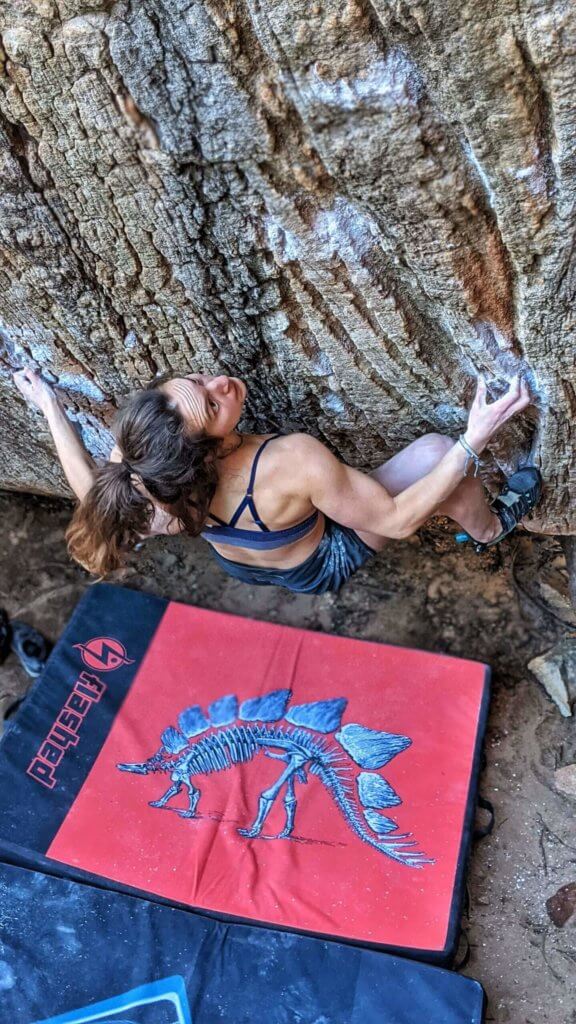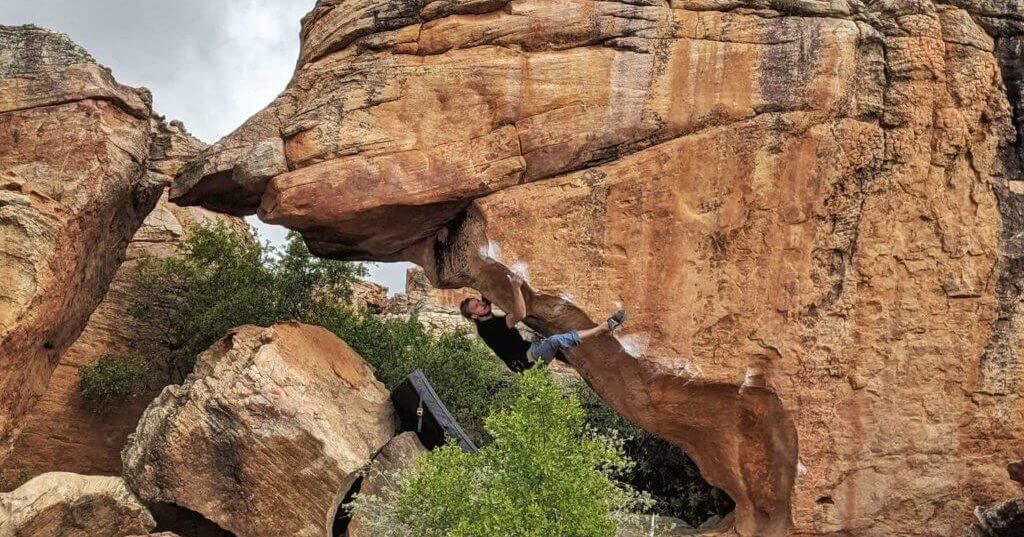by Carlos Tkacz
Introduction
Let me start by stating what is perhaps obvious: the Rocklands is a special place. And I mean that in almost every way. The climbing is some of the best in the world, maybe even the absolute best. The formations you will see there, that you will get to climb on, the colors and the shapes and swirls, are unlike anything this side of a Dr. Suess book. The landscape is stunning. Incredible blue skies during the day, punctuated with short bouts of rain that send the most vibrant rainbows arcing through the sky, are matched in beauty only by the dusty Milky Way spanning from horizon to horizon every moonless night. The hang is ridiculously easy and peaceful, with accommodations of every comfort level and all the usual comforts like wifi, restaurants, a pub, and a full-service supermarket, the Cederberg feels and is a place removed from the troubles of the world. I have travelled all over the world, both for climbing and just for the sake of traveling; The Rocklands is the only place I have returned to more than once.
South Africa is also special, however, in its storied and troubled history. In the Cederberg, you can find some of the most ancient signs of human life on the globe, but you can also see the scars of more recent problems. Like all countries that bear the stain of colonialism, you can see those problems out in the open in the townships, in the divisions of labor, in the land and in the people. Apartheid was not that long ago. Yet, there is a story of hope in South Africa as well. While they continue to struggle with corruption and the like, the people you will meet there are kind, generous, quick to laugh, and even quicker to make friends. Whenever I travel, I try and learn as much as I can about the history and culture of the place by reading, and especially by reading literature. If that is something that would interest you, please see below under the heading “Suggested Reading.”
I have been to the Rocklands eight times now, clocking a total of 60 weeks there. So when Flashed asked me to do a write-up giving some beta about making the trip, I was happy to do so. The Rocklands is a special place to me, and there is nothing I would love more than to share that with others. AS such, I have done my best to think of everything, but, if I missed anything or if you have any questions, please feel free to reach out to me. The best way is on Instagram: @boulderbushido.
One more thing: this is going to read like a travel brochure. Upon giving it a reading , after finishing the first draft, I almost felt embarrassed by how many adjectives like “amazing” and “incredible” I used. But the thing is, the Rocklands warrants these and more. I could hype it up until I am blue in the face, and it still wouldn’t be enough to do the place justice. It’s that good!
History
South Africa is also notable, however, in its storied and troubled history. In the Cederberg, you can find some of the most ancient signs of human life globally, but you can also see the scars of more recent problems. Like all countries that bear the stain of colonialism, you can see those problems out in the open in the townships. In the divisions of labor, in the land, and the people. Apartheid was not that long ago. Yet, there is a story of hope in South Africa as well.
While they continue to struggle with corruption and the like, the people you will meet there are kind, generous, quick to laugh, and even quicker to make friends. Whenever I travel, I try to learn as much as I can about the place’s history and culture by reading, especially literature. If that is something that would interest you, please see below under the heading “Suggested Reading.”
Learn More
I have been to the Rocklands five times now, clocking a total of forty weeks there. So when Flashed asked me to do a write-up giving some beta about making the trip, I was happy to do so. The Rocklands is a special place to me, and there is nothing I would love more than to share that with others. AS such, I have done my best to think of everything, but if I missed anything or have any questions, please feel free to reach out to me. The best way is on Instagram: @boulderbushido.
One more thing: this is going to read like a travel brochure. After finishing the first draft, I almost felt embarrassed by how many adjectives like “amazing” and “incredible” I used after reading it. But the thing is, the Rocklands warrants these and more. I could hype it up until I am blue in the face, and it still wouldn’t be enough to do the place justice. It’s that good!
Traveling
The first crux is getting to Cape Town. Various airlines offer flights, but the key is to find the best one with a baggage policy that will get you there with your pads. While you can rent pads from many accommodation places for around $2 a day, these pads are usually a bit more beat up than most of us would like.
Flights
The first crux is getting to Cape Town. There are a variety of airlines that offer flights, but the key is to find the best one with a baggage policy that will get you there with your pads. While you can rent pads from many of the accommodation places in Rocklands or from places in Capetown (see below)these pads are usually a bit more beat up than most of us would like. When looking for an airline, be sure to check their sporting goods policy. Many airlines have policies that will allow you to replace a checked bag with a piece of sporting equipment. They often offer guidelines on size and weight, the latter being the main concern. Generally, you can replace one baggage allowance with your pads and then still have another checked bag for your stuff. Last trip, Steph and I were able to strap two Big Squishies together and check them as a single item. In general, prices range from $1200-1600 round trip.
Rental Car
There are a plethora of rental car options of varying prices, ranging from $10/day to $25/day. All the normal companies are there, but there are also a number of cheaper options as well. Carisma and Rentacheapie are common ones and rent out older yet bullet-proof cars. First Car Rental is also a good choice. One thing to keep in mind is that you don’t need a large car to access all the usual spots. Most of the cheaper cars available for rent are small hatchbacks (think like a Chevy Sonic or maybe a VW Golf), and these work fine for the roads that lead to the climbing areas. Also, they fit a surprising amount of gear in them. Nonetheless, we always bring some straps in case we need to strap pads to the top.
Driving
Once you land and go through customs and get your car, the next crux is driving to the Cederberg. Some people choose to spend a few days in Cape Town; Steph and I usually do that in the middle of our trip as a way to get some rest. I have some information on things to do there below. The airport has wifi, so when you land you can download the necessary maps and put in wherever you are staying, but the drive is not hard. Leaving the airport spits you right onto the N2 already going the direction you need. From there, take a right (towards Malmesbury) onto the M7 and then another right onto the N7. This takes you all the way to the exit for Clanwilliam. In total, it takes about 3 hours (barring traffic) to get there from the Airport.
Here are a few tips:
- Just before you hit the N2, when leaving the airport, there is a BP gas station on the left. If you fill up here, you’ll be able to make it all the way to Clanwilliam (if you got a small car). The gas stations work like they do in Oregon. You pull up, and they fill it for you. You can tip the employee if you like. This is also a good place to get a cup of coffee and some snacks (for the coffee, you go order at the counter, then go pay at the cashier, and then use that receipt to get your coffee).
- In Piketberg, where you’ll hit the only roundabout of the drive, there is a travel center on the right where you can stop for a bathroom and some more coffee/snacks. The muffins there are amazing!
- If a truck or slower car is driving in the shoulder, that generally means they expect you to pass them and are making room. They will often expect you to do the same if you are the slow one.
- License checkpoints are common, so don’t sweat it.
- You exit from the N7 onto R364. This road is the one that takes you past Clanwilliam and up into the mountains to where most of the accommodation options are. Clanwilliam has one main street, which Ts with R364. It’ll be the first major street you come across and is where the grocery store is located. It is worth stopping to get groceries, as the Rocklands proper is still another thirty minutes or so away.
Accommodations in Rocklands
As I said above, there are tons of options, ranging from camping to houses in Clanwilliam. DePakhuys, Alpha Excelsior, and Traveler’s Rest are the most popular places to stay, though there are other options. Those three are in Rocklands itself, so while you have to drive for groceries and the like, you won’t have far to go for any of the climbing. Most of the options are farms that have pivoted to climber accommodations since a drought started long ago and since climbers started flooding the area. Prices range from $7 a night per person for camping to $100+ a night for multi-room houses that fit up to four
adults. Steph and I have stayed at all three, and we prefer Alpha Excelsior. For us, it offers the best price-to-comfort ratio. Also, the family that runs it are just the absolute best, and they make some damn good wine there! It is also where the Hen House is; more on that below. Either way, shop around and start early! Places fill up fast!
Amenities
There are two full service grocery stores in Clanwilliam, one just off the R364 on the main street and another in a shopping center just down the street from there. This shopping center also has a CVS type store, a coffee shop, and a few clothing stores. Near that there is a butcher’s store and a hardware store. Clanwilliam also has two gas stations and a few restaurants. All of it is on Google, so just look for what you need and explore!
While Clanwilliam has most of what you need, some things can be obtained in the valley where the climbing is. The Hen House is a great coffee shop that serves all kinds of treats and meals. Travelers’ Rest has a restaurant and a small store where you can get some simple things.


Climbing Gear and Guidebook
Chalk, tape, and brushes can be bought from either Alpha Excelsior or Travelers’ Rest, though there isn’t much more available than that. You can sometimes find cool, handmade chalk bags when they are available. For pads or shoes, you have to venture into one of the gyms or outdoor shops in Cape Town.
A guidebook is available, which you can buy online before you leave or at Alpha Excelsior. Another option, and the one we use, is the 27crags premium topo for Rocklands. It’s inexpensive, the app is good, the GPS mapping works well offline, and it has everything on there, perhaps even more. The author of the guidebook worked on the 27crags topo, so you are supporting him when you purchase through their website.
You can rent climbing pads from most of the accommodations. There is also a company in Cape Town that rents pads. You can find them on Instagram at @bigrigclimbers.
Non-Climbing Things to Do and Try
There are a ton of wonderful things to do in the country, and in no way will this be an exhaustive list:
- The Braii: this is essentially South African BBQ. Almost every place you rent there will have access to a braii, which is what they call their brick cooking spaces. Some things that make the braii unique compared to, say, asado culture in Argentina, is that they use wood to cook and they use these cages that close down over your meat and that you turn over by hand. It’s simple to try but difficult to master. You basically start by building yourself a log cabin of wood (which you can buy basically anywhere) as high as you can without it toppling, use some kerosene blocks (available at the grocery store) to light it up, drink a few beers or glasses of wine while you wait for the wood to collapse into a bed of embers, and then use the cage and some stands (either rebar or brick) to slow cook whatever delicious meat you bought from the store. I highly recommend giving it a go and trying a bit of everything. The premade kabobs from SPAR are especially delicious.
- Biltong: this is basically South African jerky. Sometimes it’s made of beef, sometimes eland. It’s generally less dried than American jerky. Always delicious! I highly recommend getting it by the kg in the store on the top floor of the SuperSpar (one of the grocery stores) or at the butcher’s.
- The Fish Fry: about an hour and a half away from Clanwilliam, just south of Lambert’s Bay, is an open air restaurant directly on the beach called Muisbosskerm. Every week, they do what is called a fish fry, which is essentially a kind of buffet. It works like this: you arrive early, have a few drinks on the beach, and they bring out food as it is prepared. There are a variety of dishes, and what they have depends on the day’s catch. It is very fresh and very good, and they have other meat options as well if you’re not into fish. Highly recommend! Just don’t expect to send the next day. You can ask for more information wherever it is you are staying.
- Cape Town: this beautiful city is certainly worth checking out. There is a ton to do, and it is pretty easy to find good AirBnbs in any part of town. Here are some highlights (any of these can be researched online for more specific beta):
- Penguin Beach: personally, I think penguins are gross, but they are cute and people love them. It certainly is entertaining to watch them waddle around freely, and the beach itself is beautiful.
- The Natural History Museum: this is a very interesting museum that has exhibitions on the evolutionary history of the area. They also have a fantastic planetarium.
- The District Six Museum: a sobering look at the effects of apartheid on the people of South Africa.
- The Waterfront: shopping and restaurants.
- There is so much more! Ask the locals and explore!
- Buffelsfontein Game & Nature Reserve: South Africa is well known for its safari parks and gamereserves, many of which are pretty far from the Rocklands. Buffelsfontein is a small reserve that is affordable, close by, has good accommodations and a tasty restaurant, and some amazing animals. A plus is that most of the animals are rescues!
- Hiking: The Rocklands is littered with wonderful hikes and sights to see, from ancient art to amazing arches to incredible waterfalls. Just ask around!
Suggested Reading
The following books are a primer on the history and culture of South Africa. I have tried to include some modern writers as well, as South Africa has a few up-and-coming writers worth keeping an eye on. Again, by no means exhaustive, but not a wrong place to start!
A History of South Africa by Frank Welsh
July’s People by Nadine Gordimer
Cry, The Beloved Country by Alan Paton
Long Walk to Freedom by Nelson Mandela
The Power of One by Bryce Courtenay
The Valley by C. Louis Leipoldt
Triangulum by Masande Ntshanga
More trips planned? Check out our beta for Joe’s Valley.


